Ganesh Ramakrishnan
DrishtiKon: Multi-Granular Visual Grounding for Text-Rich Document Images
Jun 26, 2025Abstract:Visual grounding in text-rich document images is a critical yet underexplored challenge for document intelligence and visual question answering (VQA) systems. We present \drishtikon, a multi-granular visual grounding framework designed to enhance interpretability and trust in VQA for complex, multilingual documents. Our approach integrates robust multi-lingual OCR, large language models, and a novel region matching algorithm to accurately localize answer spans at block, line, word, and point levels. We curate a new benchmark from the CircularsVQA test set, providing fine-grained, human-verified annotations across multiple granularities. Extensive experiments demonstrate that our method achieves state-of-the-art grounding accuracy, with line-level granularity offering the best trade-off between precision and recall. Ablation studies further highlight the benefits of multi-block and multi-line reasoning. Comparative evaluations with leading vision-language models reveal the limitations of current VLMs in precise localization, underscoring the effectiveness of our structured, alignment-based approach. Our findings pave the way for more robust and interpretable document understanding systems in real-world, text-centric scenarios. Code and dataset has been made available at https://github.com/kasuba-badri-vishal/DhrishtiKon.
Enhancing Multi-Image Question Answering via Submodular Subset Selection
May 15, 2025Abstract:Large multimodal models (LMMs) have achieved high performance in vision-language tasks involving single image but they struggle when presented with a collection of multiple images (Multiple Image Question Answering scenario). These tasks, which involve reasoning over large number of images, present issues in scalability (with increasing number of images) and retrieval performance. In this work, we propose an enhancement for retriever framework introduced in MIRAGE model using submodular subset selection techniques. Our method leverages query-aware submodular functions, such as GraphCut, to pre-select a subset of semantically relevant images before main retrieval component. We demonstrate that using anchor-based queries and augmenting the data improves submodular-retriever pipeline effectiveness, particularly in large haystack sizes.
FairPO: Robust Preference Optimization for Fair Multi-Label Learning
May 05, 2025

Abstract:We propose FairPO, a novel framework designed to promote fairness in multi-label classification by directly optimizing preference signals with a group robustness perspective. In our framework, the set of labels is partitioned into privileged and non-privileged groups, and a preference-based loss inspired by Direct Preference Optimization (DPO) is employed to more effectively differentiate true positive labels from confusing negatives within the privileged group, while preserving baseline classification performance for non-privileged labels. By framing the learning problem as a robust optimization over groups, our approach dynamically adjusts the training emphasis toward groups with poorer performance, thereby mitigating bias and ensuring a fairer treatment across diverse label categories. In addition, we outline plans to extend this approach by investigating alternative loss formulations such as Simple Preference Optimisation (SimPO) and Contrastive Preference Optimization (CPO) to exploit reference-free reward formulations and contrastive training signals. Furthermore, we plan to extend FairPO with multilabel generation capabilities, enabling the model to dynamically generate diverse and coherent label sets for ambiguous inputs.
Language translation, and change of accent for speech-to-speech task using diffusion model
May 04, 2025Abstract:Speech-to-speech translation (S2ST) aims to convert spoken input in one language to spoken output in another, typically focusing on either language translation or accent adaptation. However, effective cross-cultural communication requires handling both aspects simultaneously - translating content while adapting the speaker's accent to match the target language context. In this work, we propose a unified approach for simultaneous speech translation and change of accent, a task that remains underexplored in current literature. Our method reformulates the problem as a conditional generation task, where target speech is generated based on phonemes and guided by target speech features. Leveraging the power of diffusion models, known for high-fidelity generative capabilities, we adapt text-to-image diffusion strategies by conditioning on source speech transcriptions and generating Mel spectrograms representing the target speech with desired linguistic and accentual attributes. This integrated framework enables joint optimization of translation and accent adaptation, offering a more parameter-efficient and effective model compared to traditional pipelines.
Inducing Robustness in a 2 Dimensional Direct Preference Optimization Paradigm
May 03, 2025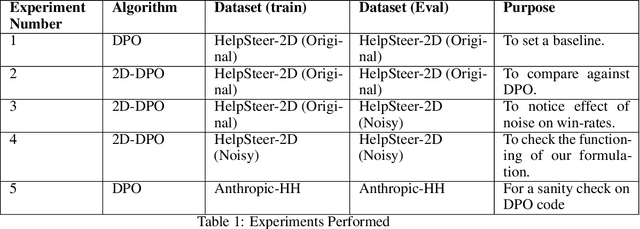

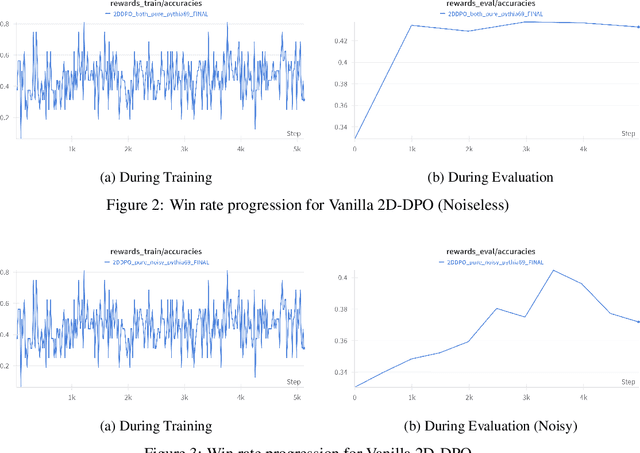

Abstract:Direct Preference Optimisation (DPO) has emerged as a powerful method for aligning Large Language Models (LLMs) with human preferences, offering a stable and efficient alternative to approaches that use Reinforcement learning via Human Feedback. In this work, we investigate the performance of DPO using open-source preference datasets. One of the major drawbacks of DPO is that it doesn't induce granular scoring and treats all the segments of the responses with equal propensity. However, this is not practically true for human preferences since even "good" responses have segments that may not be preferred by the annotator. To resolve this, a 2-dimensional scoring for DPO alignment called 2D-DPO was proposed. We explore the 2D-DPO alignment paradigm and the advantages it provides over the standard DPO by comparing their win rates. It is observed that these methods, even though effective, are not robust to label/score noise. To counter this, we propose an approach of incorporating segment-level score noise robustness to the 2D-DPO algorithm. Along with theoretical backing, we also provide empirical verification in favour of the algorithm and introduce other noise models that can be present.
Early Exit and Multi Stage Knowledge Distillation in VLMs for Video Summarization
Apr 30, 2025Abstract:We introduce DEEVISum (Distilled Early Exit Vision language model for Summarization), a lightweight, efficient, and scalable vision language model designed for segment wise video summarization. Leveraging multi modal prompts that combine textual and audio derived signals, DEEVISum incorporates Multi Stage Knowledge Distillation (MSKD) and Early Exit (EE) to strike a balance between performance and efficiency. MSKD offers a 1.33% absolute F1 improvement over baseline distillation (0.5%), while EE reduces inference time by approximately 21% with a 1.3 point drop in F1. Evaluated on the TVSum dataset, our best model PaLI Gemma2 3B + MSKD achieves an F1 score of 61.1, competing the performance of significantly larger models, all while maintaining a lower computational footprint. We publicly release our code and processed dataset to support further research.
MorphTok: Morphologically Grounded Tokenization for Indian Languages
Apr 14, 2025



Abstract:Tokenization is a crucial step in NLP, especially with the rise of large language models (LLMs), impacting downstream performance, computational cost, and efficiency. Existing LLMs rely on the classical Byte-pair Encoding (BPE) algorithm for subword tokenization that greedily merges frequent character bigrams. This often leads to segmentation that does not align with linguistically meaningful units. To address this, we propose morphology-aware segmentation as a pre-tokenization step prior to applying BPE. To facilitate morphology-aware segmentation, we create a novel dataset for Hindi and Marathi, incorporating sandhi splitting to enhance the subword tokenization. Experiments on downstream tasks show that morphologically grounded tokenization improves performance for machine translation and language modeling. Additionally, to handle the ambiguity in the Unicode characters for diacritics, particularly dependent vowels in syllable-based writing systems, we introduce Constrained BPE (CBPE), an extension to the traditional BPE algorithm that incorporates script-specific constraints. Specifically, CBPE handles dependent vowels. Our results show that CBPE achieves a 1.68\% reduction in fertility scores while maintaining comparable or improved downstream performance in machine translation, offering a computationally efficient alternative to standard BPE. Moreover, to evaluate segmentation across different tokenization algorithms, we introduce a new human evaluation metric, \textit{EvalTok}, enabling more human-grounded assessment.
SPRINT: Script-agnostic Structure Recognition in Tables
Mar 15, 2025Abstract:Table Structure Recognition (TSR) is vital for various downstream tasks like information retrieval, table reconstruction, and document understanding. While most state-of-the-art (SOTA) research predominantly focuses on TSR in English documents, the need for similar capabilities in other languages is evident, considering the global diversity of data. Moreover, creating substantial labeled data in non-English languages and training these SOTA models from scratch is costly and time-consuming. We propose TSR as a language-agnostic cell arrangement prediction and introduce SPRINT, Script-agnostic Structure Recognition in Tables. SPRINT uses recently introduced Optimized Table Structure Language (OTSL) sequences to predict table structures. We show that when coupled with a pre-trained table grid estimator, SPRINT can improve the overall tree edit distance-based similarity structure scores of tables even for non-English documents. We experimentally evaluate our performance across benchmark TSR datasets including PubTabNet, FinTabNet, and PubTables-1M. Our findings reveal that SPRINT not only matches SOTA models in performance on standard datasets but also demonstrates lower latency. Additionally, SPRINT excels in accurately identifying table structures in non-English documents, surpassing current leading models by showing an absolute average increase of 11.12%. We also present an algorithm for converting valid OTSL predictions into a widely used HTML-based table representation. To encourage further research, we release our code and Multilingual Scanned and Scene Table Structure Recognition Dataset, MUSTARD labeled with OTSL sequences for 1428 tables in thirteen languages encompassing several scripts at https://github.com/IITB-LEAP-OCR/SPRINT
MHQA: A Diverse, Knowledge Intensive Mental Health Question Answering Challenge for Language Models
Feb 21, 2025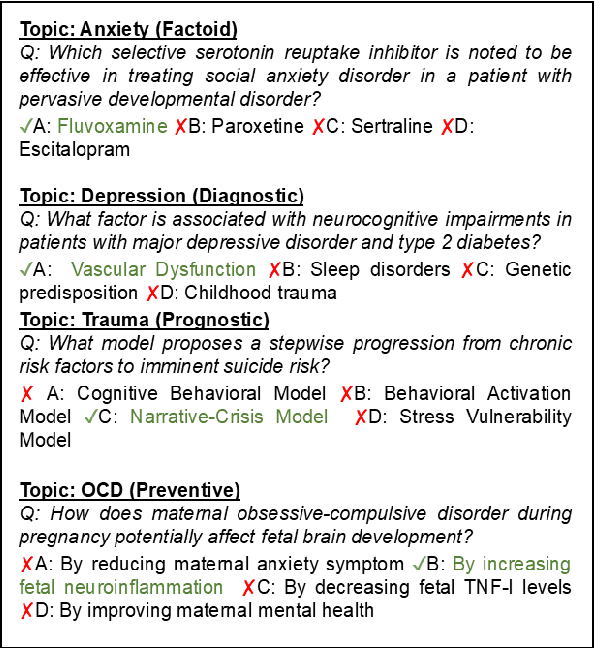
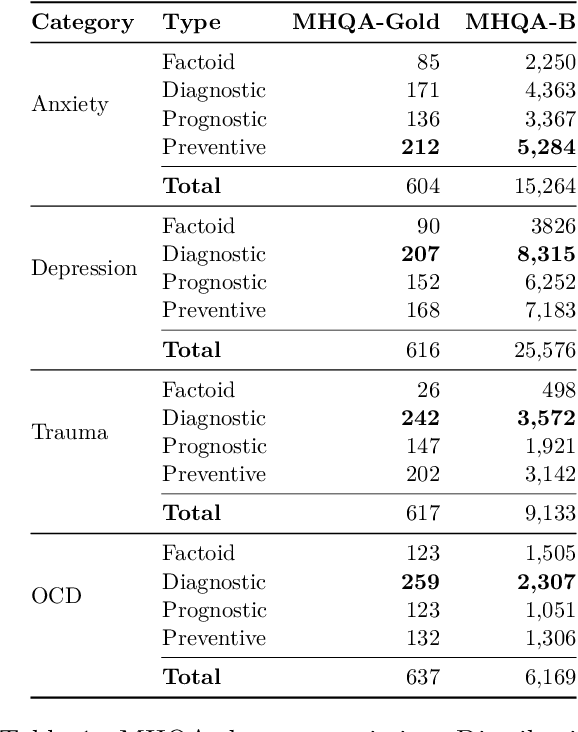
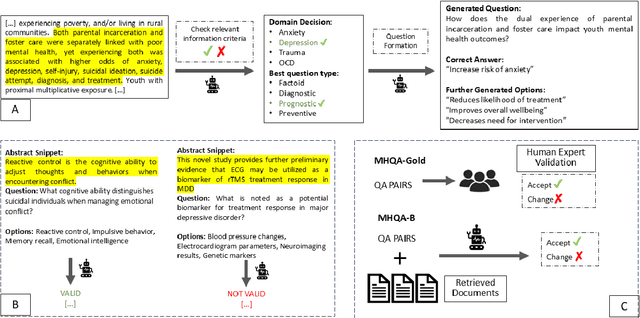
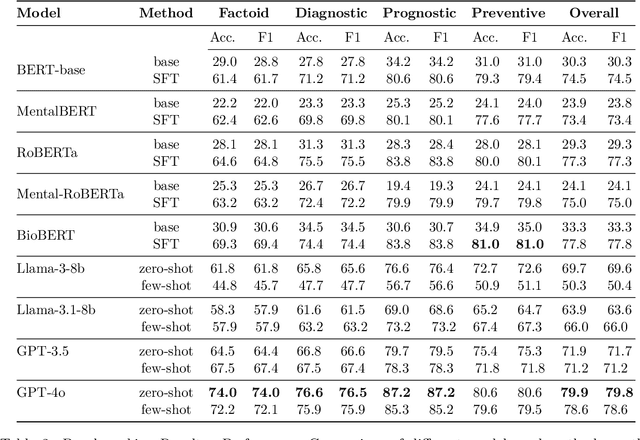
Abstract:Mental health remains a challenging problem all over the world, with issues like depression, anxiety becoming increasingly common. Large Language Models (LLMs) have seen a vast application in healthcare, specifically in answering medical questions. However, there is a lack of standard benchmarking datasets for question answering (QA) in mental health. Our work presents a novel multiple choice dataset, MHQA (Mental Health Question Answering), for benchmarking Language models (LMs). Previous mental health datasets have focused primarily on text classification into specific labels or disorders. MHQA, on the other hand, presents question-answering for mental health focused on four key domains: anxiety, depression, trauma, and obsessive/compulsive issues, with diverse question types, namely, factoid, diagnostic, prognostic, and preventive. We use PubMed abstracts as the primary source for QA. We develop a rigorous pipeline for LLM-based identification of information from abstracts based on various selection criteria and converting it into QA pairs. Further, valid QA pairs are extracted based on post-hoc validation criteria. Overall, our MHQA dataset consists of 2,475 expert-verified gold standard instances called MHQA-gold and ~56.1k pairs pseudo labeled using external medical references. We report F1 scores on different LLMs along with few-shot and supervised fine-tuning experiments, further discussing the insights for the scores.
PLATTER: A Page-Level Handwritten Text Recognition System for Indic Scripts
Feb 10, 2025Abstract:In recent years, the field of Handwritten Text Recognition (HTR) has seen the emergence of various new models, each claiming to perform competitively better than the other in specific scenarios. However, making a fair comparison of these models is challenging due to inconsistent choices and diversity in test sets. Furthermore, recent advancements in HTR often fail to account for the diverse languages, especially Indic languages, likely due to the scarcity of relevant labeled datasets. Moreover, much of the previous work has focused primarily on character-level or word-level recognition, overlooking the crucial stage of Handwritten Text Detection (HTD) necessary for building a page-level end-to-end handwritten OCR pipeline. Through our paper, we address these gaps by making three pivotal contributions. Firstly, we present an end-to-end framework for Page-Level hAndwriTTen TExt Recognition (PLATTER) by treating it as a two-stage problem involving word-level HTD followed by HTR. This approach enables us to identify, assess, and address challenges in each stage independently. Secondly, we demonstrate the usage of PLATTER to measure the performance of our language-agnostic HTD model and present a consistent comparison of six trained HTR models on ten diverse Indic languages thereby encouraging consistent comparisons. Finally, we also release a Corpus of Handwritten Indic Scripts (CHIPS), a meticulously curated, page-level Indic handwritten OCR dataset labeled for both detection and recognition purposes. Additionally, we release our code and trained models, to encourage further contributions in this direction.
 Add to Chrome
Add to Chrome Add to Firefox
Add to Firefox Add to Edge
Add to Edge